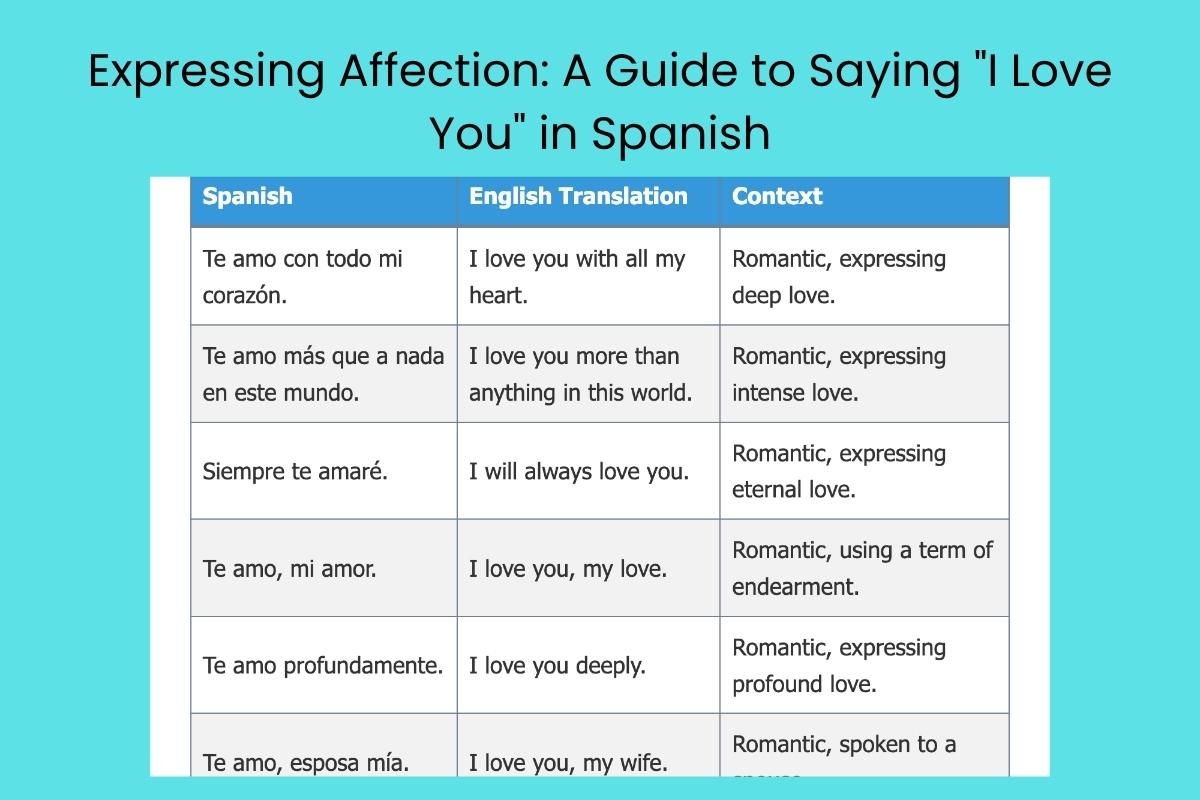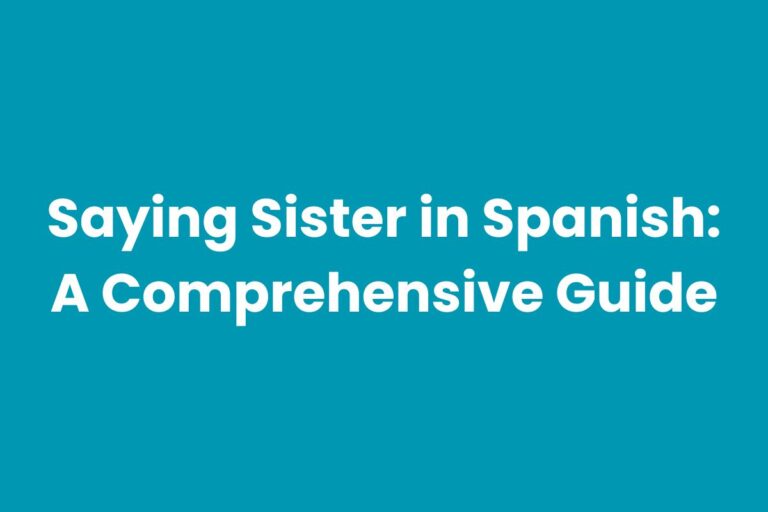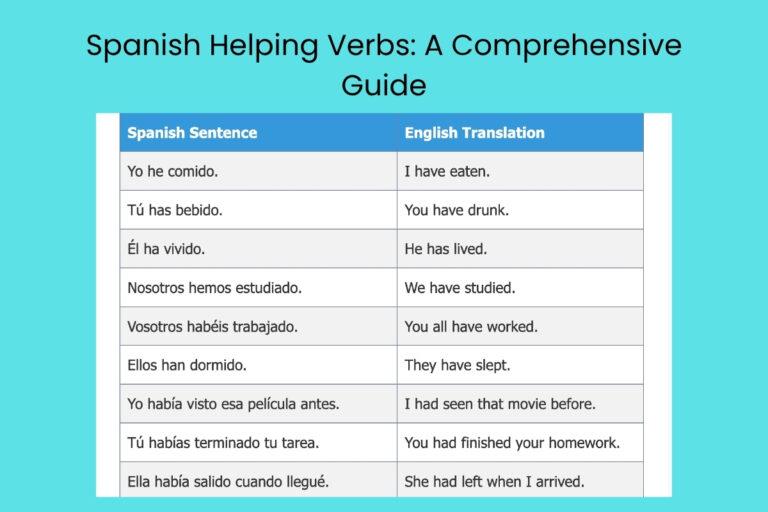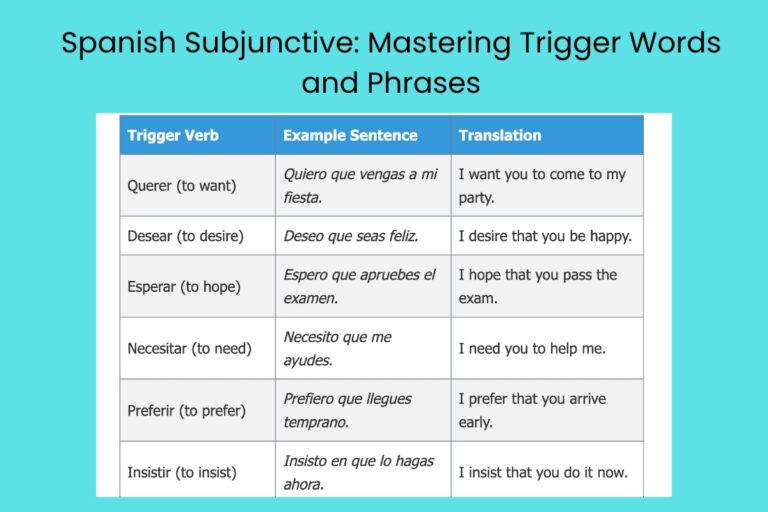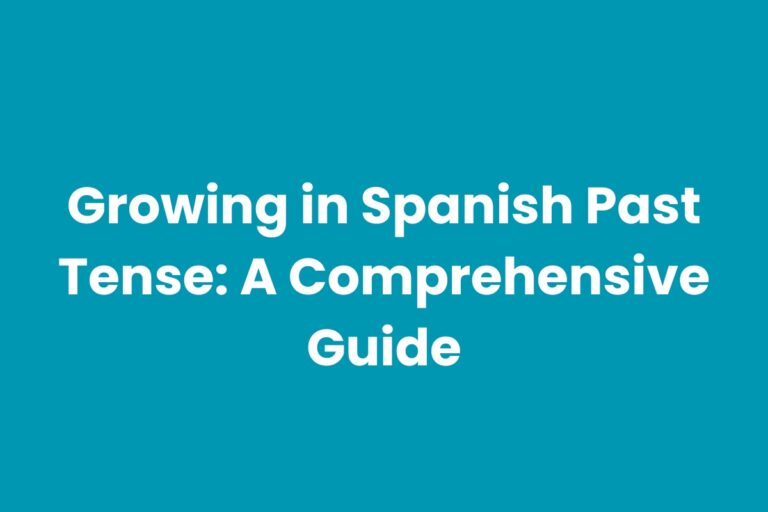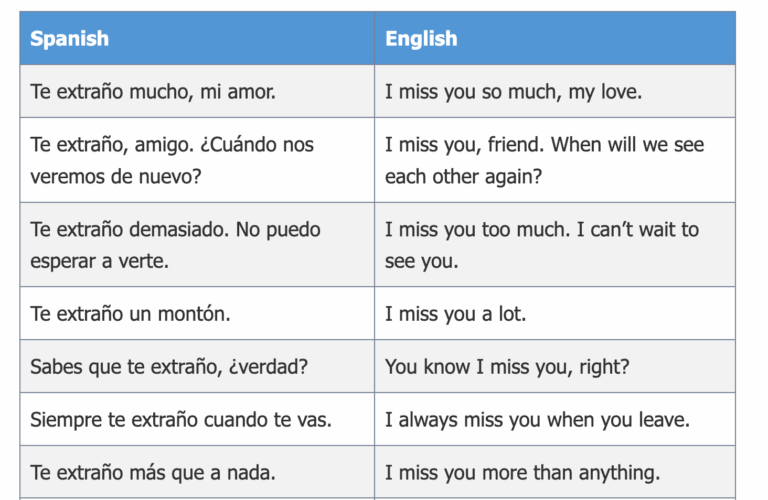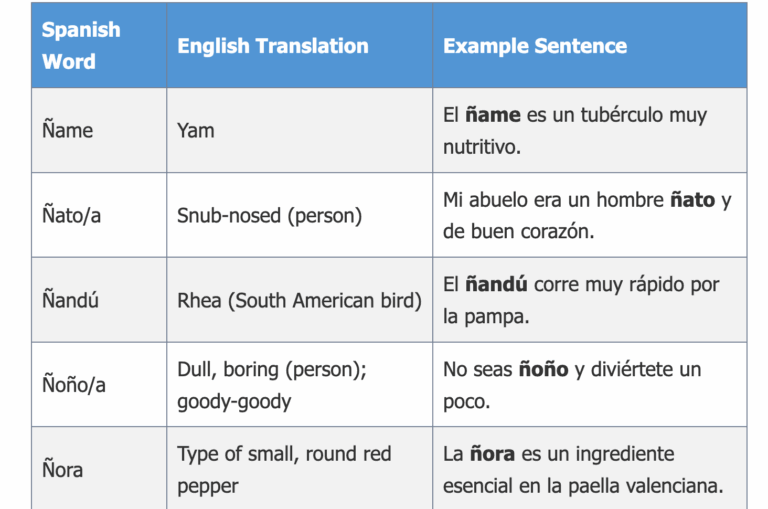Expressing Affection: A Guide to Saying “I Love You” in Spanish
Learning how to express your feelings in another language is a rewarding experience, especially when it comes to matters of the heart. Spanish, with its rich culture and passionate expressions, offers several ways to say “I love you.” This article provides a comprehensive guide to understanding the nuances of expressing affection in Spanish, from the basic phrases to more complex and culturally relevant expressions.
It explores the grammar, usage, and context behind these phrases, ensuring you can communicate your feelings accurately and sincerely. This guide is perfect for language learners, travelers, or anyone looking to connect with Spanish speakers on a deeper emotional level.
Table of Contents
- What Does “I Love You” Mean in Spanish?
- Structural Breakdown of “Te Amo” and “Te Quiero”
- Types of “I Love You” in Spanish
- Examples of “I Love You” in Spanish
- Usage Rules for Expressing Love in Spanish
- Common Mistakes When Expressing Love in Spanish
- Practice Exercises
- Advanced Topics: Nuances and Intensifiers
- Frequently Asked Questions
- Conclusion
What Does “I Love You” Mean in Spanish?
In Spanish, the concept of “I love you” is expressed primarily through two phrases: Te amo and Te quiero. While both translate to “I love you” in English, their connotations and appropriate contexts differ significantly. Understanding these differences is crucial for effectively communicating your feelings and avoiding misunderstandings.
Te amo is generally reserved for expressing deep, romantic love. It’s the phrase you would use with a significant other, spouse, or someone you have a profound connection with. It conveys a sense of passion, commitment, and intense affection. Think of it as the equivalent of “I love you” in its most serious and heartfelt form in English.
Te quiero, on the other hand, is a more versatile phrase that can express love, affection, or even strong friendship. While it can be used in romantic relationships, it’s also appropriate for family members, close friends, and even pets. It conveys a sense of fondness, care, and appreciation, but it doesn’t necessarily imply the same level of romantic intensity as “Te amo.” It is often considered the equivalent of “I love you” or “I like you a lot” depending on the context and relationship.
Structural Breakdown of “Te Amo” and “Te Quiero”
Both phrases, “Te amo” and “Te quiero,” follow a similar grammatical structure. They consist of a pronoun and a verb, with the pronoun indicating the recipient of the love and the verb expressing the act of loving.
Let’s break down each phrase:
*
:
*
: This is the object pronoun “you” (informal, singular). It indicates who is receiving the love.
*
: This is the first-person singular present tense conjugation of the verb
(to love). It means “I love.”
*
:
*
: Same as above, the object pronoun “you” (informal, singular).
*
: This is the first-person singular present tense conjugation of the verb
(to want, to love). In this context, it means “I love” or “I want.”
The word order in Spanish is generally Subject-Verb-Object (SVO), but in these cases, the subject pronoun “yo” (I) is often omitted because the verb conjugation already indicates who is performing the action. Therefore, “Yo te amo” and “Yo te quiero” are grammatically correct but less common in everyday speech, unless you want to emphasize the “I.”
Types of “I Love You” in Spanish
“Te Amo”: Deep and Romantic Love
“Te amo” is the most profound way to express love in Spanish. It’s reserved for situations where you want to convey deep, romantic feelings.
It’s typically used between partners in a serious relationship, spouses, or when expressing intense love for a family member (though less common).
Using “Te amo” implies a strong emotional connection, commitment, and a deep appreciation for the other person. It’s not a phrase to be used casually or with someone you’ve just met.
It carries significant weight and should be used with sincerity.
“Te Quiero”: Love, Affection, and Friendship
“Te quiero” is a more versatile expression of love and affection. It can be used in a variety of contexts, including romantic relationships, friendships, and family relationships.
It conveys a sense of fondness, care, and appreciation, but it doesn’t necessarily imply the same level of romantic intensity as “Te amo.”
Think of “Te quiero” as a way to express that you care deeply for someone without necessarily implying romantic love. It’s appropriate for close friends, siblings, parents, grandparents, and even pets!
It’s a warm and friendly expression that can strengthen bonds and show appreciation.
Other Expressions of Love and Affection
Beyond “Te amo” and “Te quiero,” there are many other ways to express love and affection in Spanish. These expressions can add nuance and depth to your communication and allow you to tailor your message to the specific situation and relationship.
Here are a few examples:
*
: I love you (literally, “you enchant me”). This phrase expresses a strong liking or infatuation.
*
: I’m in love with you. This is a more direct way to express romantic feelings. The ending changes based on the speaker’s gender: “enamorado” for a male speaker and “enamorada” for a female speaker.
*
: You are my life. This expresses that someone is incredibly important to you.
*
: My love. This is a common term of endearment.
*
: Darling/Sweetheart. Another common term of endearment.
*
: I adore you. This expresses deep affection and admiration.
Examples of “I Love You” in Spanish
Here are some examples of how to use “Te amo,” “Te quiero,” and other expressions of love and affection in Spanish. The tables below illustrates variations in usage and context.
“Te Amo” Examples
The following table shows examples of using “Te Amo” in various contexts. Note the romantic and serious tone implied by the usage of this phrase.
| Spanish | English Translation | Context |
|---|---|---|
| Te amo con todo mi corazón. | I love you with all my heart. | Romantic, expressing deep love. |
| Te amo más que a nada en este mundo. | I love you more than anything in this world. | Romantic, expressing intense love. |
| Siempre te amaré. | I will always love you. | Romantic, expressing eternal love. |
| Te amo, mi amor. | I love you, my love. | Romantic, using a term of endearment. |
| Te amo profundamente. | I love you deeply. | Romantic, expressing profound love. |
| Te amo, esposa mía. | I love you, my wife. | Romantic, spoken to a spouse. |
| Te amo, esposo mío. | I love you, my husband. | Romantic, spoken to a spouse. |
| Te amo, aunque a veces me exasperas. | I love you, even though you sometimes exasperate me. | Romantic, expressing love despite flaws. |
| Te amo incondicionalmente. | I love you unconditionally. | Romantic, expressing unconditional love. |
| Te amo desde el primer día que te vi. | I have loved you since the first day I saw you. | Romantic, recalling the beginning of the relationship. |
| Te amo más cada día. | I love you more each day. | Romantic, expressing growing love. |
| No sabes cuánto te amo. | You don’t know how much I love you. | Romantic, emphasizing the depth of love. |
| Te amo con locura. | I love you madly. | Romantic, expressing passionate love. |
| Te amo más allá de las palabras. | I love you beyond words. | Romantic, love that is hard to express. |
| Te amo por quien eres. | I love you for who you are. | Romantic, expressing acceptance and love. |
| Te amo y siempre te voy a amar. | I love you and I will always love you. | Romantic, reinforcing commitment. |
| Te amo, eres el amor de mi vida. | I love you, you are the love of my life. | Romantic, expressing lifelong love. |
| Quiero que sepas que te amo. | I want you to know that I love you. | Romantic, emphasizing the declaration. |
| Te amo más que a mi propia vida. | I love you more than my own life. | Romantic, expressing ultimate devotion. |
| Te amo eternamente. | I love you eternally. | Romantic, expressing everlasting love. |
| Madre, te amo. | Mother, I love you. | Familial, expressing deep love for a mother (less common than “Te quiero”). |
| Padre, te amo. | Father, I love you. | Familial, expressing deep love for a father (less common than “Te quiero”). |
| Te amo, mi reina. | I love you, my queen. | Romantic, using a term of endearment. |
| Te amo, mi rey. | I love you, my king. | Romantic, using a term of endearment. |
“Te Quiero” Examples
The following table demonstrates the use of “Te Quiero” in various contexts. Notice the more casual and versatile nature of this phrase.
| Spanish | English Translation | Context |
|---|---|---|
| Te quiero mucho. | I love you a lot. | Friendly, expressing affection. |
| Te quiero, mamá. | I love you, Mom. | Familial, expressing love to a mother. |
| Te quiero, papá. | I love you, Dad. | Familial, expressing love to a father. |
| Te quiero, amigo/a. | I love you, friend. | Friendly, expressing love to a friend. |
| Te quiero, hermano/a. | I love you, brother/sister. | Familial, expressing love to a sibling. |
| Te quiero un montón. | I love you a ton. | Friendly, expressing a lot of affection. |
| Te quiero muchísimo. | I love you very much. | Friendly, expressing a great deal of affection. |
| Te quiero con todo mi corazón, mamá. | I love you with all my heart, Mom. | Familial, expressing deep love to a mother. |
| Te quiero, abuela. | I love you, Grandma. | Familial, expressing love to a grandmother. |
| Te quiero, abuelo. | I love you, Grandpa. | Familial, expressing love to a grandfather. |
| Te quiero, aunque seas un poco loco. | I love you, even though you’re a little crazy. | Friendly, expressing affection with a lighthearted tone. |
| Te quiero tal como eres. | I love you just the way you are. | Friendly/Romantic, expressing acceptance and affection. |
| Te quiero porque siempre estás ahí para mí. | I love you because you’re always there for me. | Friendly, expressing gratitude and affection. |
| Te quiero mucho, eres como de mi familia. | I love you a lot, you’re like family to me. | Friendly, expressing a close bond. |
| Te quiero, eres una gran persona. | I love you, you’re a great person. | Friendly, expressing admiration and affection. |
| Te quiero más de lo que imaginas. | I love you more than you can imagine. | Friendly/Romantic, expressing strong affection. |
| Te quiero, mi perro. | I love you, my dog. | Affectionate, expressing love to a pet. |
| Te quiero, mi gato. | I love you, my cat. | Affectionate, expressing love to a pet. |
| Te quiero mucho, gracias por todo. | I love you a lot, thank you for everything. | Friendly, expressing gratitude and affection. |
| Te quiero y te aprecio mucho. | I love you and I appreciate you a lot. | Friendly, expressing both affection and appreciation. |
| Te quiero ver pronto. | I want to see you soon. | Friendly, expressing desire to meet. |
| Te quiero cerca. | I want you near. | Friendly/Romantic, expressing desire to be close. |
| Te quiero en mi vida. | I want you in my life. | Friendly/Romantic, expressing a desire for presence. |
Examples of Other Expressions
This table provides examples of different expressions of love and affection beyond “Te amo” and “Te quiero,” showcasing the variety of ways to express feelings in Spanish.
| Spanish | English Translation | Context |
|---|---|---|
| Me encantas. | I love you (you enchant me). | Romantic, expressing infatuation or strong liking. |
| Estoy enamorado de ti. (Male speaker) | I’m in love with you. | Romantic, expressing being in love (male). |
| Estoy enamorada de ti. (Female speaker) | I’m in love with you. | Romantic, expressing being in love (female). |
| Eres mi vida. | You are my life. | Romantic, expressing that someone is essential. |
| Mi amor. | My love. | Romantic, term of endearment. |
| Cariño/a. | Darling/Sweetheart. | Romantic/Friendly, term of endearment. |
| Te adoro. | I adore you. | Romantic/Friendly, expressing deep affection. |
| Eres el amor de mi vida. | You are the love of my life. | Romantic, expressing lifelong love. |
| Eres muy importante para mí. | You are very important to me. | Friendly/Romantic, expressing importance. |
| Pienso mucho en ti. | I think about you a lot. | Friendly/Romantic, expressing thinking about someone. |
| Me haces muy feliz. | You make me very happy. | Friendly/Romantic, expressing happiness. |
| No puedo vivir sin ti. | I can’t live without you. | Romantic, expressing dependency. |
| Eres mi todo. | You are my everything. | Romantic, expressing that someone is everything. |
| Quiero pasar el resto de mi vida contigo. | I want to spend the rest of my life with you. | Romantic, expressing commitment. |
| Eres la persona más especial en mi vida. | You are the most special person in my life. | Friendly/Romantic, expressing specialness. |
| Siento algo muy fuerte por ti. | I feel something very strong for you. | Romantic, expressing strong feelings. |
| Me importas mucho. | You matter a lot to me. | Friendly/Romantic, expressing importance. |
| Eres mi sol. | You are my sunshine. | Romantic, expressing brightness. |
| Eres mi ángel. | You are my angel. | Romantic, expressing purity. |
| Estoy loco/a por ti. | I’m crazy about you. | Romantic, expressing intense infatuation. |
Usage Rules for Expressing Love in Spanish
Expressing love in Spanish requires attention to grammar and cultural context. Here are some important rules to keep in mind.
Pronoun Placement
In Spanish, object pronouns like “te” usually come before the conjugated verb. This is different from English, where the pronoun typically follows the verb.
Correct: Te amo. (I love you.)
Incorrect: Amo te. (This is grammatically incorrect.)
However, when using infinitives or gerunds, the pronoun can be attached to the end of the verb.
Example: Quiero amarte. (I want to love you.) OR Te quiero amar. (I want to love you.)
Example: Estoy amándote. (I am loving you.) OR Te estoy amando. (I am loving you.)
Verb Conjugation
Make sure to use the correct verb conjugation for the first-person singular (I). “Amo” is the correct conjugation of “amar,” and “quiero” is the correct conjugation of “querer” in the present tense.
Correct: Yo te amo. / Te amo. (I love you.)
Incorrect: Yo te ama. (This is grammatically incorrect.)
Correct: Yo te quiero. / Te quiero. (I love you/I want you.)
Incorrect: Yo te quiere. (This is grammatically incorrect.)
Cultural Context Considerations
Understanding the cultural context is crucial when expressing love in Spanish. As mentioned earlier, “Te amo” is a strong expression reserved for deep, romantic love.
Using it casually or with someone you don’t know well can be inappropriate.
“Te quiero” is a safer option for expressing affection to friends and family. It’s a more versatile phrase that conveys warmth and care without implying romantic intensity.
In some Spanish-speaking cultures, physical affection, such as hugs and kisses on the cheek, is more common than in others. Pay attention to the customs of the specific region or country you are in to avoid making anyone uncomfortable.
Common Mistakes When Expressing Love in Spanish
Here are some common mistakes to avoid when expressing love in Spanish:
| Incorrect | Correct | Explanation |
|---|---|---|
| Amo te. | Te amo. | Incorrect pronoun placement. |
| Quiero te. | Te quiero. | Incorrect pronoun placement. |
| Yo te ama. | Yo te amo. / Te amo. | Incorrect verb conjugation. |
| Yo te quiere. | Yo te quiero. / Te quiero. | Incorrect verb conjugation. |
| Using “Te amo” with a friend. | Using “Te quiero” with a friend. | “Te amo” is too strong for platonic relationships. |
| Assuming “Te quiero” always means romantic love. | Understanding “Te quiero” can also mean affection or friendship. | Context is important to determine the meaning. |
| Ignoring gender agreement with “enamorado/a.” | Using “enamorado” if you are male and “enamorada” if you are female. | Gender agreement is important in Spanish. |
Practice Exercises
Test your understanding of expressing love in Spanish with these practice exercises.
| Question | Answer |
|---|---|
| How would you say “I love you” to your best friend in Spanish? | Te quiero. |
| How would you say “I love you” to your spouse in Spanish? | Te amo. |
| Translate: “I am in love with you” (female speaker). | Estoy enamorada de ti. |
| Translate: “I love you a lot, Mom.” | Te quiero mucho, mamá. |
| Which phrase is more appropriate for expressing deep, romantic love: “Te amo” or “Te quiero”? | Te amo. |
| Fill in the blank: _____ amo con todo mi corazón. | Te. |
| Fill in the blank: _____ quiero mucho, amigo. | Te. |
| How would a male speaker say “I am in love with you”? | Estoy enamorado de ti. |
| Is it appropriate to use “Te amo” with a casual acquaintance? Why or why not? | No, it’s not appropriate. “Te amo” expresses deep, romantic love and is too strong for casual acquaintances. |
| What is the difference between “Te amo” and “Te quiero”? | “Te amo” expresses deep, romantic love, while “Te quiero” expresses love, affection, or friendship. |
| Question | Answer |
|---|---|
| Translate: “You are the love of my life.” | Eres el amor de mi vida. |
| Translate: “I adore you.” | Te adoro. |
| Which phrase would you use to tell your parents you love them? | Te quiero. |
| Which phrase would you use to tell your significant other you love them deeply? | Te amo. |
| Fill in the blank: ____ hago muy feliz. | Me. |
| Translate: “I think about you a lot.” | Pienso mucho en ti. |
| Correct the sentence: “Amo te mucho.” | Te amo mucho. |
| Correct the sentence: “Quiero te mucho.” | Te quiero mucho. |
| Is is possible to use the term “te amo” with family? | Yes, but it is far more common to hear “te quiero” with most family members. |
| What is the literal translation of “Me encantas”? | You enchant me. |
Advanced Topics: Nuances and Intensifiers
For those looking to further refine their expression of love in Spanish, understanding nuances and intensifiers can be incredibly helpful.
Using Intensifiers
Intensifiers are words that strengthen the meaning of a verb or adjective. They can be used to add emphasis to your expressions of love.
Examples:
*
: A lot.
(I love you a lot.)
*
: Very much.
(I love you very much.)
*
: With all my heart.
(I love you with all my heart.)
*
: Deeply.
(I love you deeply.)
*
: Eternally.
(I will love you eternally.)
*
: More than anything.
(I love you more than anything in the world.)
Using these intensifiers can add emotional weight and sincerity to your expressions of love.
Poetic and Figurative Language
Spanish is a language rich in poetic and figurative language. Using metaphors and similes can add a beautiful and personal touch to your expressions of love.
Examples:
*
(You are the light of my eyes.)
*
(You are my sunshine.)
*
(You are my angel.)
*
(You are my other half.)
*
(I love you like the stars.)
These expressions go beyond simple declarations of love and convey a deeper emotional connection.
Frequently Asked Questions
- What’s the difference between amar and querer?
Amar is used to express deep, romantic love, while querer conveys affection, fondness, or strong friendship. Think of amar as “to love” in its most intense form and querer as a more versatile “to love” or “to like a lot.” - When should I use Te amo?
Use Te amo when expressing deep, romantic love to a significant other, spouse, or someone with whom you share a profound connection. It’s a strong expression that should be used sincerely. - When should I use Te quiero?
Use Te quiero when expressing affection to friends, family members, or even pets. It’s a more versatile phrase that conveys warmth and care without necessarily implying romantic intensity. - Can I use Te amo with my family?
While you *can* use Te amo with family members, it is much less common than using Te quiero. Te quiero is the standard way to express love and affection to family in most Spanish-speaking cultures. Using “Te amo” with family members is reserved for expressing profound love, and might even sound a little strange sometimes. - Is it weird to say Te quiero to a romantic partner?
Not at all! Te quiero is perfectly acceptable in a romantic relationship, especially in the early stages or when expressing affection without the full weight of Te amo. It can also be used casually and frequently, even within a long-term relationship. - How do I say “I’m in love with you” in Spanish?
You would say Estoy enamorado de ti (if you are male) or Estoy enamorada de ti (if you are female). Remember to use the correct gender agreement. - What are some other ways to express affection in Spanish besides Te amo and Te quiero?
Some other expressions include Me encantas (I love you/you enchant me), Eres mi vida (You are my life), Mi amor (My love), Cariño/a (Darling/Sweetheart), and Te adoro (I adore you). - How do I make Te quiero sound more intense?
You can add intensifiers such as mucho (a lot) or muchísimo (very much). For example, Te quiero muchísimo means “I love you very much.” - What does “Te adoro” mean?
“Te adoro” means “I adore you”. It expresses deep affection and admiration, but it is less strong than “Te amo.” - Can I combine “Te amo” and “Te quiero” in a sentence?
While grammatically possible, it’s not a common or natural thing to say. It’s best to choose the phrase that best reflects the level of emotion you want to convey. - How can I learn more about expressing emotions in Spanish?
Immerse yourself in the language through movies, music, and books. Pay attention to how native speakers express their feelings and try to incorporate those expressions into your own vocabulary. You can also find online resources and language exchange partners to practice with.
Conclusion
Expressing love in Spanish is a beautiful and nuanced art. By understanding the differences between “Te amo” and “Te quiero,” as well as other expressions of affection, you can effectively communicate your feelings and build stronger connections with Spanish speakers.
Remember to consider the context, relationship, and cultural norms when choosing your words.
Continue practicing and exploring the richness of the Spanish language, and you’ll find yourself expressing your emotions with confidence and sincerity. Don’t be afraid to make mistakes; they are a natural part of the learning process.
Embrace the journey and enjoy the rewarding experience of connecting with others through the language of love. ¡Buena suerte!

